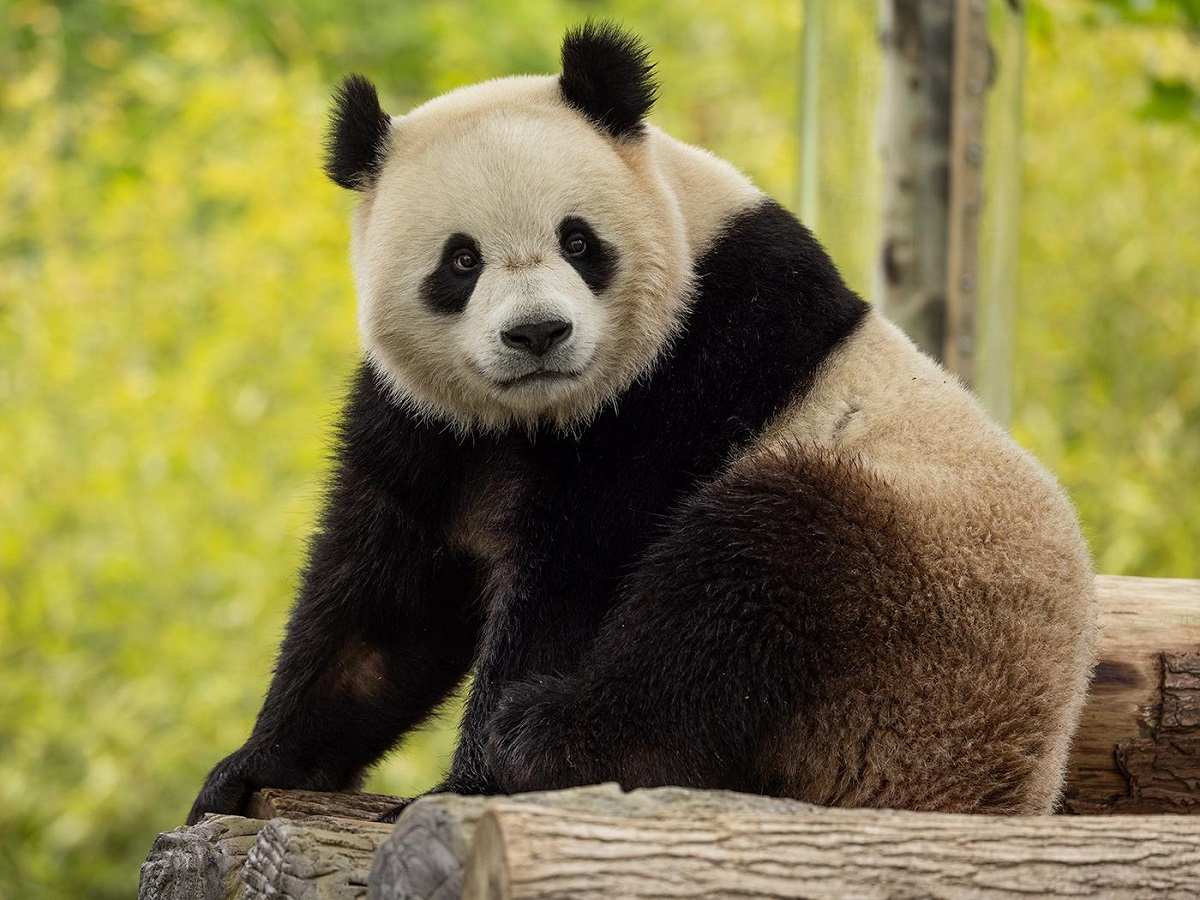

Qing Bao (Left) and Bao Li (Right) .
13:52 JST, October 15, 2024
Two giant pandas, in a plane stocked with bamboo shoots and carrots, have departed China for an hours-long flight to Washington and a new home at the National Zoo.

Memorabilia available at the National Zoo in advance of the arrival of two new giant pandas.
Just under a year after the last giant pandas left the national’s capital, fans of the black-and-white bears are eagerly awaiting Qing Bao, a 3-year-old female, and Bao Li, a 3-year-old male. Their arrival will mark the continuation of a beloved animal conservation program in Washington that goes back more than a half-century.
The zoo has been mum about the pandas’ travel plans for security reasons, but it posted on X on Monday afternoon that “something giant is coming.”
The bears are being transported on a FedEx Boeing 777 cargo jet nicknamed the “Panda Express” from Chengdu, China. FedEx also did not disclose details of the trip, but said on X on Monday that the Panda Express was “on the move.” A FedEx cargo jet from Chengdu via Anchorage is scheduled to arrive at Dulles International Airport at 9:55 a.m. Tuesday, according to FlightAware, a website that tracks air traffic.
The government-run China Wildlife Conservation Association said that the bears were given a final health check before departing, and that veterinarians and zoo keepers would escort them. In addition to the bamboo, they said Chinese cornbread, water and medicine were packed for the trip.
The zoo will be closed Tuesday for the bears’ arrival, and once they move in, it will be at least several weeks before they are on display for the public. But if all goes well, zoo-goers in Washington will soon be able to watch a new generation of the beloved bears grow from adolescence to adulthood, and maybe produce some giant panda cubs along the way.
“It’s just unbelievable,” Frances Nguyen, a panda photographer and founder of the Pandas Unlimited Facebook group, said after hearing the news Monday.
She said she has been photographing the zoo’s gorillas since the last pandas left in November, but she still found herself stopping by the unoccupied panda compound.
“I would stop by and see the yard,” she said in a telephone interview. “It’s so empty.”
“Of course, I met my husband there, so it’s always my special place,” she said. “It’s going to be super exciting.”
“I almost thought, ‘They’re never coming back,’” she said. “So this is good.”
The agreement to send the pandas followed concern in the past few years that the decades-long partnership that allowed giant pandas to come to the zoo might be in jeopardy, in part because of complicated and sometimes tense relations between the United States and China.
Brandie Smith, the zoo’s director, has said giant pandas have drawn millions of visitors to D.C., and millions more have watched the animals on the zoo’s panda cam.
“I was always certain that pandas would return,” Smith said in a telephone interview this month. “But if you asked me last year how long it would take … I would have said we will need to wait a few years.”
“I think it’s a testament to our team, to our science, to our relations that it will be less than a year when giant pandas return,” she said.
The pandas’ departure has been controversial in China, with nationalist accounts on social media calling to “keep Chinese pandas in China.”
But the China wildlife association said, “We believe that the new round of China-US international cooperation on the conservation of giant pandas will build on the good cooperation and achieve more … scientific and technological exchanges, as well as the wild conservation of giant pandas.”
Elliott L. Ferguson II, president of Destination DC, a local travel and tourism nonprofit, said in a statement: “The giant pandas are an iconic part of the Washington, D.C. story, both for locals and incoming travelers. … The National Zoo will be the only place in the U.S. to see giant pandas for free.”
But it will be at least several weeks before visitors get their first chance to glimpse the pandas. Once they arrive, the bears will be quarantined for a minimum of 30 days to reduce the risk of introducing parasites or disease to other animals. Then they’ll get a little more quiet time to get used to their habitat and the zookeepers.
The pandas are coming to a renovated panda compound that has new lush sod, new climbing structures and a new panda “hammock” made out of lengths of fire hose.
There are new murals inside showing scenes of misty mountains. There’s new flooring and new viewing glass. Higher fences have been built, and the air conditioning has been upgraded. There are also 40 new cameras in the panda cam system.
As for food, the zoo has the recipe for Chinese panda bread, Smith said. And some American food will be tried.
“For example, our sweet potatoes, we cook our sweet potatoes for them,” she said. “They’re a little extra sweet when you do that. So little twists that we use here. We want to make sure that they enjoy it.”
The new pandas are on a 10-year lease, ending in April 2034, during which the zoo will pay the China Wildlife Conservation Association $1 million a year, the zoo has said. In an agreement signed by the zoo and Chinese officials in April, the parties agreed to cooperate and exchange scientific information about giant panda conservation.
The first giant pandas came to D.C. in 1972 as a gift from China. Since then, other pandas have come under an agreement with China but eventually returned home. Four surviving cubs have been born at the zoo.
New panda Bao Li has family roots in the District.
He is the son of Bao Bao, a female giant panda who was born at the zoo in 2013, and the grandson of Mei Xiang and Tian Tian, the zoo’s most recent panda couple residents.
China owns and leases all giant pandas in U.S. zoos, and has agreements that require the animals and their cubs to go to China after their tenure in the United States. Mei Xiang, 25, and Tian Tian, 26, and their offspring, Xiao Qi Ji, went back in November.
When word came in May that new pandas were coming, there was excitement in the zoo and beyond. First lady Jill Biden said in a video announcement: “We can’t wait to celebrate this historic moment … It’s official! The pandas are coming back to D.C.!”
The National Zoo, which is part of the Smithsonian Institution, has had eight giant pandas in the past. The newcomers will make 10.
As few as 1,864 giant pandas live in the wild, the zoo says on its website. Another 600 live in zoos and breeding centers around the world.
The Smithsonian’s 163-acre zoo in Northwest Washington is home to 2,200 animals representing 400 species. It sees about 1.9 million visitors a year. Admission is free. Its Conservation Biology Institute, on a 3,200-acre campus near Front Royal, Va., conducts breeding, veterinary and conservation research in a rural setting.
"News Services" POPULAR ARTICLE
-

American Playwright Jeremy O. Harris Arrested in Japan on Alleged Drug Smuggling
-

Japan’s Nikkei Stock Average as JGB Yields, Yen Rise on Rate-Hike Bets
-

Japan’s Nikkei Stock Average Licks Wounds after Selloff Sparked by BOJ Hike Bets (UPDATE 1)
-

Japanese Bond Yields Zoom, Stocks Slide as Rate Hike Looms
-

Japan’s Nikkei Stock Average Buoyed by Stable Yen; SoftBank’s Slide Caps Gains (UPDATE 1)
JN ACCESS RANKING
-

Keidanren Chairman Yoshinobu Tsutsui Visits Kashiwazaki-Kariwa Nuclear Power Plant; Inspects New Emergency Safety System
-

Imports of Rare Earths from China Facing Delays, May Be Caused by Deterioration of Japan-China Relations
-

University of Tokyo Professor Discusses Japanese Economic Security in Interview Ahead of Forum
-

Japan Pulls out of Vietnam Nuclear Project, Complicating Hanoi’s Power Plans
-

Govt Aims to Expand NISA Program Lineup, Abolish Age Restriction























